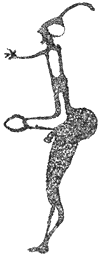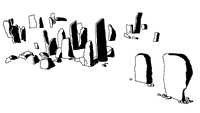| Contents
Abstracts |
Abstracts of Sahara volume 14
(published July 2003)
|
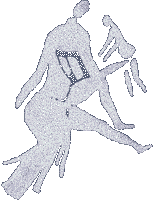
|
Stefano Biagetti et Savino Di Lernia
Vers un modèle ethnographique-écologique d'une société pastorale préhistorique saharienne
ABSTRACT
The realization of the archeology of the pastoral societies was obtained by very thoroughly integrating the multidisciplinary investigations. The scope of this work was to flexibly and uninterruptedly apply ethnographic, ecological and ethnohistorical data to an archeological case. Proposed here, in particular, is the reexamination - in the light of extra-archeological information - of a 6th millennium BP pastoral community of the Acacus mountains (Libyan Sahara). The aim of this reexamination was to evaluate the magnitude and quality of the human occupation in a given regional context. In effect, the methodology described is a stimulating tool, especially for interpreting its model’s wide range. The procedure’s problematic aspects are considered and discussed - with reference to present-day African situations - within the theoretical and methodological ethnoarcheological framework.
|
|
Top
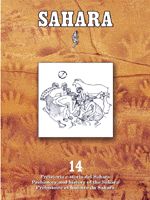
|
François Soleilhavoup
Images sexuelles dans l'art rupestre du Sahara
ABSTRACT
Certain authors have sometimes interpreted the Sahara rock art images depicting sex and sexuality as generally being fecundity or fertility themes. However, thorough, specific studies regarding the male genital organs – for example, ithyphallic or megaphallic representations – are very rare. Without pretending to have thoroughly exhausted these themes, a few well known or recently discovered rock art examples are presented here. These include rare examples of normal male genital organs, as well as more frequently seen examples of male genital organs that are abnormal, aberrant or even pathological. Mention is made of the fact that, apparently, circumcision might have been practiced during the Neolithic period. Furthermore, certain representations of the penis and testicles lead one to believe that genital diseases were not uncommon during that period. Hopefully, when a more complete inventory of rock art sexual images becomes available, a better understanding of the legends and realities that refer to the sexuality of the ancient populations of the Sahara will be possible.
|
|
Top
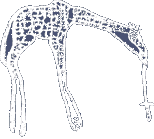
|
Maarten van Hoek
The Saharan "girafe à lien" in rock art. Domesticated giraffe or rain animal? Comparing enigmatic giraffe petroglyphs from the Sahara and Namibia
ABSTRACT
It is not rare to find the depiction in rock art of various species of animals being captured and/or domesticated. The so-called “tethered giraffe” phenomenon present in Sahara rock art is compared here with “similar” motifs found in Namibian rock art. The possibility is, therefore, considered that the “tethered giraffe” might have represented a metaphor evoking the notions of water and fertility.
|
|
Top
|
Nick Brooks, Savino Di Lernia, Nick Drake,
Margaret Raffin and Toby Savage
The geoarchaeology of Western Sahara. Preliminary results of the first Anglo-Italian expedition in the "free zone"
ABSTRACT
This paper details the results of the first Anglo-Italian geoarchaeological expedition in the "free zone" of Western Sahara. In cooperation with the SADR (Sahrawi Arab Democratic Republic), and with the support of the Frente Polisario, we surveyed the unoccupied zone of Western Sahara, which until late 1991 was inaccessible as a result of the conflict with Morocco. The survey, although brief, yielded important evidence concerning the cultural heritage of the region, indicative of continuous human occupation (from the late Pleistocene up to the middle and late Holocene), particularly in terms of funerary monuments and rock art. Palaeoenvironmental evidence is indicative of significant variations in climate, which require further research. The survey suggested important cultural links with other Saharan regions and, as well as highlighting the problems of an area affected by conflict, has gone some way to filling the gaps in our knowledge of the human past in northern Africa.
|
|
Hélène Jousse, Namy Ould Mohamed Kaber et Michel Raimbault
Aperçu archéozoologique d'un site de chasseurs au Néolithique ancien à Berouâga (Mauritanie nord-occidentale)
ABSTRACT
The neolithic Berouaga site yielded a series of specimens that helped to obtain a better understanding of the northwestern Mauritania’s lower Holocene fauna, which consisted of a wildcat, a rhinoceros, various gazelles, a buffalo and the redunca, a small antelope. Mauritania’s contemporaneous and more recent sites provide a wider variety of animals, thus indicating a richer presence of vegetation and water, while Berouaga’s climate was more arid, as demonstrated by the scant fauna diversity and predominance of gazelles. These wild species were hunted by what were among the region’s most ancient human populations.
|
|
Top
|
Werner Pichler and Alain Rodrigue
The "Tazina style"
ABSTRACT
In 1970, Lhote examined about a dozen rock-art engravings of animals in the Tazina area (western Algeria) and came to the conclusion that they had a particular style. The purpose of this article is to analyze the characteristics that distinguish the “Tazina style” and identify any new ones. We examined about 200 representations of rock art found in five locations in southern Morocco. We then selected the most frequently found engravings of antelopes and gazelles and, after carefully studying how they were made, we used modern statistical methods to define these animals according to size, proportions, horn shapes, hoof shapes, outlines, etc. What we particularly wanted to find out was how much realism was depicted and how it compared to the amount of intentional deviations from reality. One of the most interesting results is that the most significant style differences do not appear to be caused by spatial differences but, rather, by time differences. It was clearly seen that the tendency was to go from realism to schematic reductions with typical outlines, because this provided more information with less effort.
|
|
Top
|

https://www.saharajournal.com
e-mail: reception@saharajournal.com
Last update Monday, September 2, 2013
|
|
|
|



